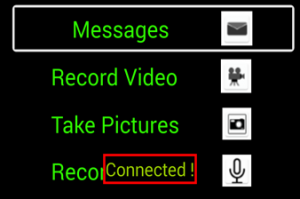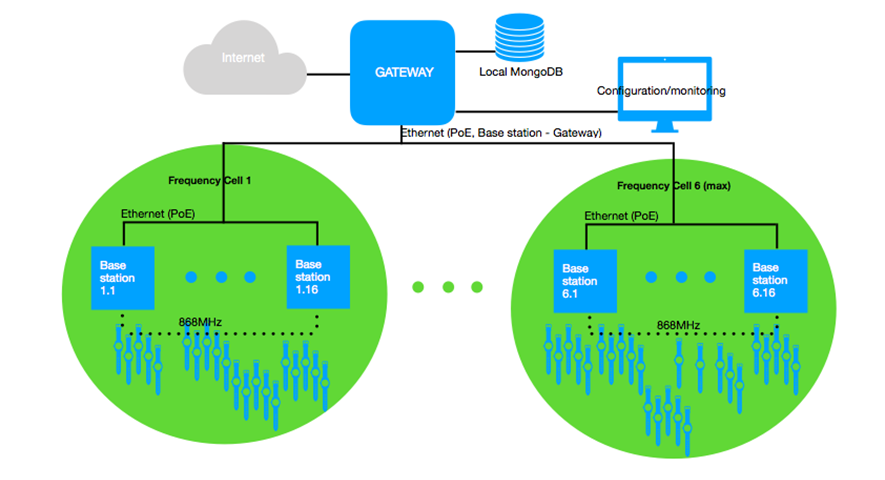Crowd and Capacity Monitoring
The MONICA Crowd and Capacity Monitoring solution is used by Smart City organisers, event organisers, security staff and first responders to monitor crowd behaviour and manage security at large events, e.g. to mitigate security and safety risk or annoyance.
This MONICA solution complements the MONICA Crowd Management and Communication solution. Combined they represent a comprehensive, closed loop solution for gathering information on crowd behaviour and event risks in real-time and presenting such information in the relevant context as decision support for those entrusted with total management of large events.

The MONICA Crowd and Capacity Monitoring is an on-site solution consisting of a series of components which can be deployed for a variety of purposes using CCTV cameras, wearables and advanced video analytics. The solution hence collects important information about crowd size and flow (crowd counting), advanced object detection, including vehicle detection as well as early warning of security threats. Providing this information to the MONICA Crowd Management and Communication solution allows security staff to obtain enhanced, contextual real-time oversight and decision support for interventions.
Overview
| Application areas | Type of locations | Main features |
|---|---|---|
|
|
|
Challenges, Features and Benefits
A smart city is a lively city; a cultural city; a city worth living in. A pinnacle in the European way of life and our whole society is precisely the love for culture; developed and refined over many centuries; effectively diffused to the most remote part of our continent; appreciated by all age groups; recognised in one form or the other by all citizens of Europe.
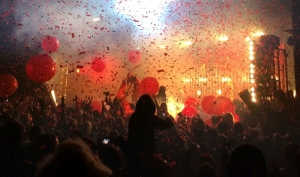
Woodstower Music Festival, Lyon
However, in the last two decades the need for enhanced security measures during the numerous city events is sadly increasing, due to the risk of terrorism; open air events are often attended by thousands of people, so crowd management and mitigation of annoyance are becoming major challenges requiring advanced ICT tools.
The challenges of crowd monitoring in open-air events are mostly related to:
- monitoring and managing the crowd itself: Mass panic, overcrowded spaces, lost persons, unauthorised vehicle in the event area, bottlenecks with high-risk queues;
- lack of proper technology: Unreliable communication tools, limited or missing network and Internet access;
- the venue: Narrow access gates, complex street topology, poor lighting and visibility.
The MONICA Crowd and Capacity Monitoring solution provides a comprehensive tool for overcoming these challenges.
To strengthen the security and safety management of such events, MONICA Crowd and Capacity Monitoring solution provides a cloud-based IoT platform supporting a series of components that can be used to monitor, record and analyse the environment and consequently detect emerging episodes at an early stage so security and first responder staff can intervene before things get out of control. By monitoring crowd capacity levels, the event organisers can ensure that they do not have more visitors than the allowed capacity at the venue, noise levels can be measure to ensure compliance with city ordinances and regulations and environmental factors can be monitored for increased safety of roller coasters, scene gear, and other event infrastructures.
The MONICA Crowd and Capacity Monitoring consists of a series of sensor components which can be deployed for a variety of purposes related to crowd behaviour, security and safety of visitors. It connects to powerful CCTV cameras and advanced video analytics, wearables and several IoT sensors such as wind speed, noise and other environmental sensors and hence is capable of collecting important information about crowd size, flow, object detection as well as early warning of security and safety threats. Providing this information to the MONICA Crowd Management and Communication solution allows security staff to obtain enhanced, real-time oversight and decision support for interventions and proposed actions.
The MONICA Crowd and Capacity Monitoring solution can be used in any type of open- air, gated and non-gated event. It can be used for short term deployment (e.g. for a specific concert); for a recurrent event (monthly or seasonal) or for semi-permanent events (night life area, traffic).
The specific features of the MONICA Crowd and Capacity Monitoring solution are:
People counting: CCTV cameras incorporating advanced video analytics are used to accurately count the number of people entering and leaving a specific area through one or more gated entrances. It is primarily used to identify the potential risk of overcrowding, but can also be used for statistical purposes, timelines of crowding, etc.
Crowd density: Advanced video analytics is used to estimate crowd size and density from the CCTV footage and results are shown as a real-time heat map on the MONICA Common Operational Picture (COP) in the control room. The information can be used to locate high density areas, so that the event organiser can take precautionary measures to avoid unattainable crowd build-ups during the event. Crowd density can also be accomplished by having visitors wearing low-cost wristbands which allows for anonymous localisation of visitors in the event area.
Human and object detection: Computer based object detection algorithms are used to identify and detect more than 100 different kind of objects in real-time, including humans and vehicles. It can be used for intervention, elimination of security threats and/or redirection/elimination of potential, emerging security threats.
Vehicle detection: This component provides real-time detection and tracking of vehicles in order to support the security staff handling of unauthorised vehicles in the event area.
Crowd flow: Using the crowd density and object detection algorithms, early warning of security threats, such as overcrowded, high-risk queues, fights or health incidents, can be achieved and immediate actions can be initiated by the security staff and first responders e.g. using the MONICA Crowd Management and Communication solution. Interventions can be in the form of security or first responders’ interventions or redirection of visitors to safer areas.
Staff tracking: The positions of stewards and other staff deployed in the event area can continuously be tracked and reported to the MONICA COP. Control room staff can then, at any moment, view the different positions of staff on the ground and obtain an overview of available resources in case of incidents or other interventions. Tracking can be performed with staff wristbands or with dedicated GPS tracking devices.
Mobile video and audio recordings: Smart Glasses, worn by the staff in the field, are able to record video and audio incidents directly from the scene and send them, in real-time, to the control room for decision support and intervention. The glasses have two-way communication capabilities.
The responsible for security, safety and first aid as well as compliance during and after the event, will benefit from the MONICA Crowd and Capacity Monitoring solution by having a comprehensive and cohesive set of tools to capture and store situational awareness information of crowds and staff. It will greatly help them during to manage crowds in real-time during the event and for post-event investigations. The specific benefits of MONICA Crowd and Capacity Monitoring solutions are:
- Provide full overview of the crowd levels in different areas
- Prevent exceeding capacity limits
- Predict critical situations and high crowd density
- Detect abnormalities within a crowd
- Report abnormalities instantly and accurately and with images
- Identify and report objects such as vehicles
- Maintain all safety levels during and around the event including e.g. wind strength
- Facilitate safe and quick entry to and exit from the event area
Technologies
The MONICA Crowd and Capacity Monitoring solution is built on several IoT capable network infrastructures. Some components are also connected via dedicated communication network and data repositories. The entire solution is embedded in a MONICA Private Cloud structure as described in the MONICA Platform Architecture and Components.
The MONICA IoT Infrastructure is capable of handling three different types of IoT devices: i) fixed sensors and fixed Cyber Physical Systems, ii) “nomadic” devices and iii) wearable devices.
- Fixed sensors and Cyber Physical Systems comprise devices mounted on fixed structures in and around the event area, e.g. cameras.
- “Nomadic” devices are quasi-mobile devices confined to the event area, such as IoT sound level meters and other sensors (e.g. temperature, wind, etc.). Cameras can also be nomadic, when mounted on controllable airships.
- Wearable devices include wristbands, glasses and mobile phone apps. Crowd wristbands are worn mainly by the spectators while staff wristbands and smart glasses are intended for the staff.

MONICA IoT Infrastructure.
The MONICA Crowd and Capacity Monitoring solution uses commercially available CCTV cameras in combinations with specific, high performance algorithms and communication infrastructure developed by MONICA partners. The solution also uses commercially available wearables such as smart glasses, wristbands, GPS trackers, wind sensors and noise monitors to collect additional information about event crowds and environmental conditions..
For developers:
🛠 Video Processing Framework
🎞 Crowd density estimation
🎞 Human and object detection
🎞 People Counting
🎞 Fight detection
Although almost all IoT devices are commercially available off-the-shelf devices, they have been enhanced and additional features have been added by the MONICA partners.
The technical concepts in the video part of the MONICA Crowd and Capacity Monitoring solution consists of: a) video capture with CCTV cameras b) one or more embedded algorithms for feature analysis and c) server communication management tools.
 Camera processing: Cameras are used for analyzing crowd behavior and density in real-time. Standard CCTV cameras are equipped with embedded analytics in two main modalities: monocular (regular CCTV cameras), and time-of-flight. Each camera type offers a range of video analytics with varying accuracies. This core camera framework (VCAcore) pre-dates the MONICA project, but it has been extended as part of the project to allow analytics developed by other partners as well as integration with the MONICA cloud layer. The MONICA version of the framework comprises the camera platform, the various algorithms that perform analysis, and software (Secure Fusing Node – SFN) that manages data from VCAcore to the cloud.
Camera processing: Cameras are used for analyzing crowd behavior and density in real-time. Standard CCTV cameras are equipped with embedded analytics in two main modalities: monocular (regular CCTV cameras), and time-of-flight. Each camera type offers a range of video analytics with varying accuracies. This core camera framework (VCAcore) pre-dates the MONICA project, but it has been extended as part of the project to allow analytics developed by other partners as well as integration with the MONICA cloud layer. The MONICA version of the framework comprises the camera platform, the various algorithms that perform analysis, and software (Secure Fusing Node – SFN) that manages data from VCAcore to the cloud.
The specific analysis and detection features implemented in the MONICA Crowd and Capacity Monitoring solution are:

Crowd density estimation: Crowd density estimation focuses on providing a single crowd count for a scene, avoiding the complications of localization and identification of individual persons. This count is based on the ability to estimate the size of groups of people and then summing those detected groups to return a final count. This strategy allows for better handling of occlusions and low resolution that is often present in surveillance camera data. It is usually achieved by summing over the map to provide the final count.
 Human and object detection: The human and object detection framework is based on feature extraction using a type of neural network called Convolutional Neural Network (CNN). In machine learning, a convolutional neural network is a class of deep, feed-forward artificial neural networks that has successfully been applied to analyzing visual imagery. The CNN is followed by region proposal and region of interest (RoI) classification. The entire system is a single, unified network for object detection. Using “attention” mechanisms, a Region Proposal Network module tells the neural network where to look for objects of interest.
Human and object detection: The human and object detection framework is based on feature extraction using a type of neural network called Convolutional Neural Network (CNN). In machine learning, a convolutional neural network is a class of deep, feed-forward artificial neural networks that has successfully been applied to analyzing visual imagery. The CNN is followed by region proposal and region of interest (RoI) classification. The entire system is a single, unified network for object detection. Using “attention” mechanisms, a Region Proposal Network module tells the neural network where to look for objects of interest.
 People counting: VCA provides a more general-purpose people counting analytic that functions on standard CCTV footage. This analytic is available as a commercial product and also as a pre-integrated analytic in VCA’s video processing framework. This people counting analytics can process video data from regular monocular cameras and can thus be applied to sites where the cameras are already installed.
People counting: VCA provides a more general-purpose people counting analytic that functions on standard CCTV footage. This analytic is available as a commercial product and also as a pre-integrated analytic in VCA’s video processing framework. This people counting analytics can process video data from regular monocular cameras and can thus be applied to sites where the cameras are already installed.
 Fight detection: The aim of this algorithm is to provide means for the real-time detection of fighting events in video streams. A fast detection algorithm has been implemented for human tracking, which used the detections of the previous component (human detection) in order to initiate new tracks and validate/rectify existing ones. A range of approaches were implemented for actual event recognition, each one composed of a different combination of feature extraction processes and classification schemes.
Fight detection: The aim of this algorithm is to provide means for the real-time detection of fighting events in video streams. A fast detection algorithm has been implemented for human tracking, which used the detections of the previous component (human detection) in order to initiate new tracks and validate/rectify existing ones. A range of approaches were implemented for actual event recognition, each one composed of a different combination of feature extraction processes and classification schemes.
In addition to the features provided by cameras and video processing, the MONICA platform contains a number of wearable devices that can be used, either as standalone crowd or personal monitoring devices, or in connection two-way communication between control room, staff and visitors.
For developers:
🗜 Staff wristbands
🗜 Crowd wristbands
🕶 Smart glasses
🖈 GPS position trackers
The technical concepts in the wearables part of the MONICA Crowd and Capacity Monitoring solution consists of: a) Wristbands for staff localisation and communication, b) wristbands for anonymous. mass localisation of visitors, c) Smart Glasses for mobile video and audio capture and d) GPS tracking devices for staff localisation.
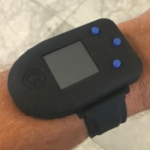 Staff wristbands: Sendrato staff wristbands provided by DEXELS are used for two-way communication between control room and the stewards in the field. The wristbands use Ultra-Wideband (UWB) two-way communication and incorporate a LED screen for user interaction. UWB-based geometrical localization is used for positioning. The infrastructure is comprised of anchors, tags, a network router, a network switch and a server running the location engine and configuration software. A browser is used to setup and monitor the system which can run on anything from a PC, a tablet to a smartphone.
Staff wristbands: Sendrato staff wristbands provided by DEXELS are used for two-way communication between control room and the stewards in the field. The wristbands use Ultra-Wideband (UWB) two-way communication and incorporate a LED screen for user interaction. UWB-based geometrical localization is used for positioning. The infrastructure is comprised of anchors, tags, a network router, a network switch and a server running the location engine and configuration software. A browser is used to setup and monitor the system which can run on anything from a PC, a tablet to a smartphone.

Crowd wristbands: Low-cost Sendrato wristbands provided by DEXELS are used for location of wearers in defined spaces. The wristbands are equipped with LED displays and narrow-band radio (868/900MHz) technologies. Base stations are placed around the venue and used to determine location to be displayed on a heatmap. The button can be used to collect user input from the visitors (“Likes”, voting or “Friend-Connect”). The material could be a leather bracelet, a textile wristband or a silicon wearable.
 Smart glasses: The Smart Glasses from OPTINVENT are used in MONICA. They have been tailored with an app (Monicora) in order to facilitate communication with the MONICA COP and present the user feedback for the person wearing the Smart Glasses. The app provides real time exchange between the COP and other stewards in the field to improve security interventions and report incidents. A user interface is superimposed on the glass itself with a menu of actions that can be performed with a Bluetooth joystick. The glasses can send and receive video files, take pictures and record audio, and display messages from the COP.
Smart glasses: The Smart Glasses from OPTINVENT are used in MONICA. They have been tailored with an app (Monicora) in order to facilitate communication with the MONICA COP and present the user feedback for the person wearing the Smart Glasses. The app provides real time exchange between the COP and other stewards in the field to improve security interventions and report incidents. A user interface is superimposed on the glass itself with a menu of actions that can be performed with a Bluetooth joystick. The glasses can send and receive video files, take pictures and record audio, and display messages from the COP.

Live Positioning Information System
Live Positioning Information System (LiPS): Location information (Longitude and latitude) of a steward or volunteer is continually collected using a MONICA GPS tracking module. The tracking devices upload the data via a LoRa communication network. The data is stored in an OGC Sensorthing server. The data model follows the OGC Sensorthings specification (Version 1). Once the database user has the knowledge of the device then corresponding “Thing” can be located, followed by corresponding “Data stream” which points to the observations.
The technical concepts in environmental sensors of the MONICA Crowd and Capacity Monitoring solution consists of: a) IoT enabled Sound Level Meters, b) wind sensors for detection strong winds during events.
 Sound Level Meters: IoT enabled accredited sound level meters provides real-time monitoring of sound levels at discrete outdoor locations. They are enabled for use in Internet of Things and is easy to deploy. They collect data in real-time and sends them directly to cloud storage. They can also perform real-time sound analysis so that sound contribution levels from different sources can be separated. More details are provided in the MONICA Sound Level Monitoring solution.
Sound Level Meters: IoT enabled accredited sound level meters provides real-time monitoring of sound levels at discrete outdoor locations. They are enabled for use in Internet of Things and is easy to deploy. They collect data in real-time and sends them directly to cloud storage. They can also perform real-time sound analysis so that sound contribution levels from different sources can be separated. More details are provided in the MONICA Sound Level Monitoring solution.
 Environmental Sensors: Sensors are used for measuring weather (wind, temperature and humidity) needed in the MONICA Adaptive Sound Field Control solution. Single wind sensors (anemometers) are used to detect wind speed for increased safety of roller coasters, scene gear, and event infrastructures. Sensor nodes could easily be integrated with the MONICA cloud standard interfaces – e.g. the SCRAL middleware and the One M2M gateway – using open standard IoT technologies, protocols and software. The sensors transmit sensor data to the MONICA Cloud and on the MONICA COP.
Environmental Sensors: Sensors are used for measuring weather (wind, temperature and humidity) needed in the MONICA Adaptive Sound Field Control solution. Single wind sensors (anemometers) are used to detect wind speed for increased safety of roller coasters, scene gear, and event infrastructures. Sensor nodes could easily be integrated with the MONICA cloud standard interfaces – e.g. the SCRAL middleware and the One M2M gateway – using open standard IoT technologies, protocols and software. The sensors transmit sensor data to the MONICA Cloud and on the MONICA COP.
The MONICA Crowd Capacity and Monitoring solution uses a broad range of communication network infrastructures and protocols, each suited to a specific part of the internal and external communication infrastructure.
Cameras: CCTV cameras includes in the MONICA cloud layer framework which facilitates integration of video sensor analytics into the MONICA cloud layer. The cameras use Ethernet (PoE) LAN networks to connect to the control room. The cameras can send video and alerts in a range of formats such as HTTP, TCP, SMTP for integration into other layers of the MONICA platform. Video is streamed in a range of formats including MJPEG over HTTP and H.264 over RTSP/RTP.
The Short Range Communication (SRC) devices use a variety of different protocols:
Smart glasses: Use WiFi b, g, and n protocol @ 2.4GHz for communication, Bluetooth 4.0 Low Energy for user handling, and µUSBS 2.0 for charging, data exchange and transporting mono audio to an audio headset accessory.
Staff wristbands: Use UWB (Ultra Wide Band) communication for positioning and communication.
Crowd wristbands: Use 868Mhz networks and proprietary communication protocols for positioning and communication and RFID for contacts. TCP/IP based communication, both Ethernet and WiFi, as well as several low-bandwidth wireless communication technologies are supported. Altogether this creates a highly fault-tolerant communication channel between the base stations.
Live Positioning Information System (LiPS): GPS trackers uses LoRa (Long Range) communication infrastructures. LoRa uses license-exempt sub-gigahertz radio frequency bands like 433 MHz, 868 MHz (Europe) and enables long-range transmissions (more than 10 km in rural areas) with low power consumption. LoRa is available from telco operators in most countries. The communication channel is encrypted with a secure key for every device. Time, location, ID and packet counter is transmitted.
Other IoT devices: The IoT Sound Level Meters may use standard 3G/4G network for data communication, but can also use standard WiFi, if available.
Environmental devices: Wind sensors use WiFi communication.
M2M Network Service Capabilities Layer (NSCL): TIM has developed a OneM2M compliant gateway for External Platform connectivity of MONICA services. The ETSI compliant M2M platform is accessible in the cloud and will be deployed as PaaS (Platform as a Service).
The MONICA Crowd and Capacity Monitoring solution is a complex solution that relies on both external components and technologies, enablers and tools from the MONICA project partners. Please contact the responsible partner listed below for more information.
Interfaces to the MONICA Cloud services
The MONICA Data Sources API functions as interface layer between the MONICA IoT Platform and the MONICA Cloud services as described in the MONICA Platform Architecture and Components. The following subsystems are installed:
- The Device Layer includes all IoT wearables (g., wristbands and glasses) and IoT sensors, which can be fixed (e.g., sound level meters, loudspeakers, cameras, environmental sensors) or mobile;
- The Network Layer that allows the effective communication between the heterogeneous IoT wearables, IoT devices and the IoT platform modules. This layer is responsible of forwarding data coming from the IoT wearables and IoT sensors as well as of responding to service requests coming from upper layers;
- The Edge Layer includes a set of processing modules (g., the Wearables GW running localization algorithms, Processing Units executing video-based algorithms, the MONICA Adaptive Sound Field Control solution (ASFC) for managing the sound quality and noise reduction) that process real-time data directly from the Device Layer
IoT devices
In the MONICA Crowd and Capacity Monitoring can be complemented with any combination of IoT sensors which suites the need to provide contextual information for crowd monitoring for a specific event. The flexibility has been demonstrated in a large number of MONICA demonstrations as listed below. The IoT sensors used for these demonstrations comprise:
- Cameras
- CCTV cameras
- 3rd party image analysing algorithms
- Blimps, airships and balloons for airborne “nomadic” cameras
- Wearables
- Staff wristbands for staff
- Crowd IoT wristbands for visitors
- Smart glasses
- GPS trackers for staff
- Other IoT devices
- Environmental sensors (wind, humidity, temperature)
- Sound Level Meters
External technologies required
The MONICA Crowd and Capacity Monitoring solutions are built on commercial products that can be sourced directly from the manufacturer:
- CCTV Cameras are commercially available from a range of manufactures
- Original VCAcore algorithms (crowd density algorithm, gate counting algorithm) for the cameras are available from VCA Technology Ltd.
- The Blimps are available from DigiSky S.r.l.
- Sendrata Staff Wristbands are available from Dexels BV
- Sendrata Crowd Wristbands are available from Dexels BV
- ORA-2 Smart Glasses are available from Optinvent S.A.
- Sound Level Monitors are available from Brüel & Kjær A/S
Internal MONICA enablers and tools required
The remaining components are available from the MONICA partners as listed below
- MONICA Platform Core Enabler
- MONICA Crowd Monitoring Enabler
- MONICA Crowd Control Enabler
- MONICA Security Enabler
- MONICA Crowd Flow Algorithm
- MONICA Human & Object Detection Algorithm
- MONICA Fight Detection Algorithm
- MONICA Staff Wristband and Applications
- MONICA Crowd Wristbands and Applications
- MONICA Monicora Smart Glass Applications
- Live Positioning Information System (LiPS)
- MONICA Environmental Sensors for measuring weather conditions
- SCRAL layer middleware and OneM2M compliant gateways
Scalability
The following scalability issues should be considered:
Scalability of the IoT platform: The IoT platform has been tested for crowd monitoring applications using cameras in several pilot demonstrations and using crowd wristbands in three demonstrations. Before going to the real large-scale demonstration with the crowd wristbands, the IoT platform has been intensively tested and improved in terms of scalability thanks to a wristbands emulator that is able to generate localization messages form a configurable number of wristbands. Using this emulator, the overall IoT platform has been able to support a flow of localization data from 10.000 wristbands updated, for instance, every 30 seconds. During the Woodstower Festival 2019, a total of 6.230 crowd wristbands were used by visitors and the IoT platform performed very well without introducing any delay or interruption of the services. In principle, more wristbands could be supported by the IoT platform, without overloading it, if we can relax the updated period parameter. The IoT platform has been able to support a flow of localization data from 10.000 wristbands whose positions were updated, for instance, every 30 seconds. In principle, more wristbands could be supported by the IoT platform, without overloading it, if we can relax the update periodicity parameter.
Scalability of the Security Fusion Node: The SFN along with VCAcore are designed to be scalable and capable to handle multiple cameras and algorithms simultaneously. For a single site there would be one instance of the SFN and VCAcore with the algorithms running on a processing node. If required, more processing nodes running instances of VCAcore with the algorithms can be added to handle additional cameras. All instances of VCAcore would point to the single instance of the SFN.
Scalability of the staff wristband network Infrastructure: The staff wristband, based on the UWB technology, also uses a network of base stations, called anchors. Each anchor must be able to communicate with a nearby master anchor. The master anchor is responsible for collecting ranging and user data from normal anchors. In addition, the master anchor must be able to offload its data to a LAN. The number of anchors and master anchors is only limited by the 3 bytes that are used to identify an anchor. Hence, in theory, the network can scale to large amounts of anchors. In practice the largest networks that have been used in practice consisted of 100s of anchors. In principle, the total number of staff (UWB) tags is also only limited by the 3 bytes that identify a tag. However, there is only a limited number of time slots available to communicate ranging data; currently this limit is 1.000.
Scalability of the crowd wristbands: The crowd wristband protocol uses parallel time slots allowing a large number of wristbands to connect to the infrastructure and exchange messages. In more details, four radio channels are simultaneously used by a cluster of 16 base stations. In order to avoid interference, within a single radio channel, wristbands can send messages using a TDMA protocol. In particular, the wristband protocol relies on a tight clock-synchronisation with a frame duration of 250 ms. A total of 96 base stations can be deployed in an event area, this results in a maximum reporting throughput of almost 6.400 messages per second. The total number of wristbands supported by the infrastructure depends on the network address size of the wristband, which is currently 18 bits. Thus, currently the maximum number of wristbands can be 262.144 that can be updated at least every 40,96 seconds (i.e. 262.144 / 6.400). To sum up, the number of wristbands can be increased with the network address size.
Scalability of the crowd base stations: The maximum safe range between a wristband and a base station is 75 m. This implies that a wristband must always be at maximum 75 m away from a base station in order to have coverage. This characteristic can be used to design and setup the base station infrastructure for a specific venue. Since there is a limit to the number of base stations (96), there is a limit to the maximum area that can be covered. However, thanks to the large coverage area of the wristband infrastructure, the crowd density information can be estimated in an area much larger than the coverage area provided by CTTV cameras. Over the course of an event, millions of messages are being collected by the GW that estimates the wristbands’ locations and sends the result to the MONICA cloud infrastructure
Scalability of the smart glasses: Up to 10 devices were used in Leeds in the Rugby – Varsity (October 2019) and the IoT platform showed good performance. Considering that the message update from glasses is similar to GPS trackers, a larger number of devices could be supported without overloading the platform.
Associated MONICA solutions
The MONICA Crowd and Capacity Monitoring solution is closely related to and have been demonstrated together with these additional MONICA solutions:
Implementation
The MONICA Crowd and Capacity Monitoring solution can also be implemented as a customer specific solution independent of other MONICA solutions.
Preparation
The following information should be investigated and prepared before implementation is commenced:
Communication: Wireless LAN communication: A stable WiFi network is required to avoid data loss and a high bandwidth for advanced functionalities requiring audio recording such as source contribution identification. whereas the
Cameras: The location of visitors is measured by the cameras and used to calculate a crowd density. The resolution of this discrete density field is typically 5 m x 5 m. Preparation for using the camera solutions include:
- Determine camera requirements and needed accessories. Possible requirements to be considered for the selection of the cameras: Required accuracy, availability of mounting locations, Illumination constraints, color/B&W video required, area to be covered, density of people to be measured, budget available, etc.
- Investigate installation details. The most suitable mounting height / angle of attack for Time-of-Flight cameras in the locations is identified for each position of the cameras
- Identify the supporting infrastructure including cable harnesses, availability of power, availability of reliable internet access, space requirements for processing equipment in the control room,
- Identify the required network infrastructure (wired or wireless) including capability of streaming real-time video from the cameras to the processing nodes.
- Investigate PC requirements: 1 Processing unit in situ in the server should be available. It can be the processing node, 16 channels, but a regular PC can be used as well. The processing node runs some algorithms for crowd size estimation. A common PC (as in 2020) with modern CPU and GPU e.g. Intel i7 CPU, 64GB RAM, NVIDIA RTX2080 GPU, will suffice to process all algorithm on two video channels.
- Consider data storage requirements such as a) constraints (e.g. video data must not be stored, can be stored if does not contain personal data, etc); b) expected duration of the event and the amount of data; c) a detailed map of the area and the event (including metadata/info e.g. camera locations, security personnel locations, etc.)
- The algorithms need to be trained for the actual location. Training of the system can take a long time and should be done prior to the installation. Performance of the system will be directly linked with the availability of training data.
- The CCTV cameras can be mounted not only on fixed structures, but also on Unmanned Aircraft Systems such as Blimps and Balloons. Blimps can be positioned accurately above the event area and are able to communicate with the MONICA IoT platform by means of either Wi-Fi or ad-hoc radio link. Such ventures require special planning and the MONICA point of contact should be involved as soon as possible.
Staff wristbands: The layout and placement of the anchors that communicate with the staff wristbands via UWB must be carefully planned and the following limitations need to be considered:
- All anchors need to be in range with the UWB master in order to correctly calculate the anchors’ coordinates
- Anchors should be mounted on a stable structure at a height of 3-4 meters above the
- The anchors should be shielded against water.
Crowd wristbands: The crowd wristbands need a dedicated infrastructure of base stations that communicate with each other and with the wristbands.
- The maximum safe range between a wristband and a base station is 75 m. This implies that a wristband must always be at maximum 75 m away from a base station in order to have coverage.
- Same is applicable to the base stations as for the anchors above.
Live Positioning Information System (LiPS): The GPS tracking units have a limited battery life, and re-charging should be taken into account during events with long duration:
- Battery lifetime: about 16 hours
- Charging: about 7 hours from empty to full
Deployment
The following information is provided for the organiser of the event for the deployment of the solution:
- Installation of cameras and wiring can be performed by local technicians once the layout has been approved by the responsible for the installation.
- For gate counting the cameras should have an inclination of 90°.
- Network and power shall be provided by the organiser.
- The Processing Node is remotely accessible. It shall be active by the local organiser as soon as possible before the event allowing able time for adjustment and final training of the system.
- The organiser shall provide the rule on capacity as soon as possible for the Decision Support System (e.g. Area: 30m2, less than 2 person/ m2 → ok/green, 2-3 person/m2 → warning/orange, more than 3 person/m2 → alarm/red)
Operation
- Monitoring of accuracy of counts is needed.
- Remote support by the solution provider during the event is normally adequate for correct operation. For the most part, the system is operating autonomous.
The MONICA Crowd and Capacity Monitoring solution can be reproduced by using the Crowd and Capacity Monitoring Toolbox. This Toolbox allows the user to demonstrate the Crowd and Capacity Monitoring solution by instantiating and running the involved MONICA components. In particular, the MONICA platform can use either anonymous stored data or emulated data.
In case stored data shall be used for demonstration, the Replayer tool can be set to replay part of the crowd data based on cameras from the Rugby demonstration in Leeds (October 2019). Since the database is very large, only a small portion of it has been made available for the demonstration of the toolbox.
In case emulated data be used for demonstration, the Wristband Emulator can generate wristband positions in the event area. More specifically, the wristband emulator can generate a certain number of wristbands in four different regions of the pilot area according to a percentage vector (e.g. 30%, 20%, 40%, 10%) whose values refer to region 1, 2, 3 and 4, respectively. In each region the wristbands positions are generated according a 2D Gaussian distribution centred in a position and using a covariance matrix defined as parameters. The Toolbox includes also the HLDF (High Level Data Fusion Anomaly Detection ) for generating the crowd density based on the wristband’s positions, the Decision Support System (DSS) for generating the alerts and the MONICA Common Operational Picture (COP) for visualization purposes.
Additional resources:
The MONICA Crowd and Capacity Monitoring Toolbox:
https://github.com/MONICA-Project/DockerGlobalWristbandSimulation
The MONICA Replayer Tool:
https://github.com/MONICA-Project/observation-replayer
The MONICA Wristband Emulator:
Technical regulations
- All devices of the MONICA solutions making use of radio frequency spectrum must adhere to the various European regulatory provisions as laid forth by CEPT/ECC including some relevant EU Decisions/Directives. For further information see D12.5 Report on Standards, Regulations, and Policies for IoT Platforms.
- All devices of the MONICA solutions making use of radio frequency spectrum, must comply with the Radio Equipment Directive 2014/53/EU (RED) ), and be duly CE-marked..
- The staff wristbands comply with ETSI EN 302 065-2 V 2.1.1(Short Range Devices (SRD) using Ultra Wide Band technology (UWB); Harmonised Standard covering the essential requirements of article 3.2 of the Directive 2014/53/EU; Part 2: Requirements for UWB location tracking and further comply with the EU Commission Implementing Decision 2014/702/EU, (Amending Decision 2007/131/EC on allowing the use of the radio spectrum for equipment using ultra-wideband technology in a harmonised manner in the Community”.
- The UWB communication protocol is compliant with the IEEE802.15.4-2015(The protocol and compatible interconnection for data communication devices using low-data-rate, low-power, and low-complexity short-range radio frequency (RF) transmissions in a wireless personal area network (WPAN).
- The crowd wristbands are built to comply with ETSI EN 300 220-2 V 3.1.1 (2017-02) (Short Range Devices (SRD) operating in the frequency range 25 MHz to 1 000 MHz; Part 2: Harmonised Standard covering the essential requirements of article 3.2 of Directive 2014/53/EU for non-specific radio equipment , and later updated by EN 300 220-2 V3.2.1 (2018-06).
- The hardware must comply with the Waste Electrical and Electronic Equipment Directive (WEEE 2012/19/EU).
- The hardware must be marked with the WEEE mark.
- The CCTV cameras and other hardware sensors are an electronic equipment and the supplier and the organiser must agree on the proper take-back procedure for the used hardware.
- The hardware must comply with the Restriction of Hazardous Substances in Electrical and Electronic Equipment Directive (RoHS 2011/65/EU).
Other local/national regulations
With regard to the collection and processing of personal data, the GDPR, (EU) 2016/679, allows Member States to enact national provisions on certain issues as stipulated by the National Data Protection Authority. For example, Member States will have discretion to enact national provisions imposing further requirements regarding the appointment of Data Protection Officers.
-
-
- Internal procedures must be developed to protect personal data
- Internal procedures to protect the rights of data subjects must be implemented
- The event organiser is identified as the “Data Controller”
- The MONICA provider is identified as a “Data processor”
- A Data Processor Agreement must be drafted and signed by these two parties
- Data Processor Agreements with third parties must be in place if relevant.
- A Data Protection Officer can be designated by the Data Controller
- A Data Management Plan is required which establishes the intended processing of personal data and the purpose of such processing
- A Data Protection Impact Assessment must be carried out based on the Data Management Plan and special areas of vulnerabilities towards protection of personal data must be identified and resolved.
- Formal permission to install CCTV cameras must be granted and cameras should only record those areas that need to be surveyed for the purpose of the solution
- Standard CCTV signs must be placed by the cameras following the applicable rules for CCTV signage including the following information in a concise language:
- That you are in or about to enter into an area where video surveillance is taking place;
- Why the recording is taking place (i.e. the controller’s justification for installing a CCTV or other video system);
- The identity of the controller (or its representative) responsible for the video system;
- The rights that the data subject can avail themselves of in respect to such processing of their personal data;
- The contact details of a data protection officer or, where one is not appointed, whichever individual would be responsible for the footage being recorded, who would ideally be the same individual whom the data subjects would be able to contact to exercise their rights as mentioned in point 4 above;
- Where the data subject can find further information regarding the processing of their personal data.
-

Example of GDPR compliant CCTV notice poster
Ethics
The following specific ethical considerations shall be made:
- As a rule of thumb, video recordings with people should always be assumed to be personally identifiable data (location of identifiable persons is specifically mentioned in the GDPR regulation)
- Note, that CCTV footage may be used to implement vehicle recognition technology and thus record personal information.
- Proper graphic displays with CCTV warnings must be planned and implemented.
- Proper procedures for end-of-life of video recordings must be defined and meticulously implemented.
- Sound procedures for allowing individuals access to CCTV footage where they feature must be in place, including guidelines for how to verify the individual’s identity, identify the individual in the footage and anonymise all other individuals in the footage.
- The COP should be placed in a secure room with controlled access to prevent any form of misuse of the collected and displayed data.
- The solution may raise public concerns about increased surveillance practices and how these affect citizens’ rights to privacy. Event organisers should define the legitimate reasons for implementing the solution. It may be useful to carry out a Legitimate Interests Assessment (LIA).
Lesson Learned have been collected throughout the deployment and demonstration phases of the MONICA project and the relevant Lesson Learned are provided here for reference. Please check with the responsible partner for the newest updates.
The following main Lesson Learned from the MONICA demonstrations and reference deployments are:
- Cameras should be installed and accessible through RTSP streaming protocol at least three days prior to actual event day.
- In crowded areas with narrow streets and lots of vehicles and human traffic, it is quite challenging to calibrate the cameras. A calibration mat can be handy to ease the process.
- Availability of the Internet connection in camera location is essential and should be investigated prior to the event.
- During notifications of national spectrum regulatory authorities in a Member State with regard to a planned demonstration/test of new and novel (not yet CE-marked) radio devices, it has proved useful to reference Art 9(2) of the 2014/53/EU (RED), where a MONICA supported event area is compared to a tech-exhibition or trade fair. It should be observed, that the event area must be gated, to prevent non-compliant equipment incidentally to pass through any exit gate, with the risk of causing harmful interference to other wireless services. Observe also, that Art 9(2) of said directive instructs that non-compliant devices shall be duly marked as “demonstration/not for sale”.
Replication
Business Models
The Business Model Canvas is used to give a high-level overview of the contents in the value configuration and in the customer group side related to a specific value proposition. This tool is used to map out all details of the MONICA business models based on the value proposition, target groups, the partner constellations, and revenue models outlined below.
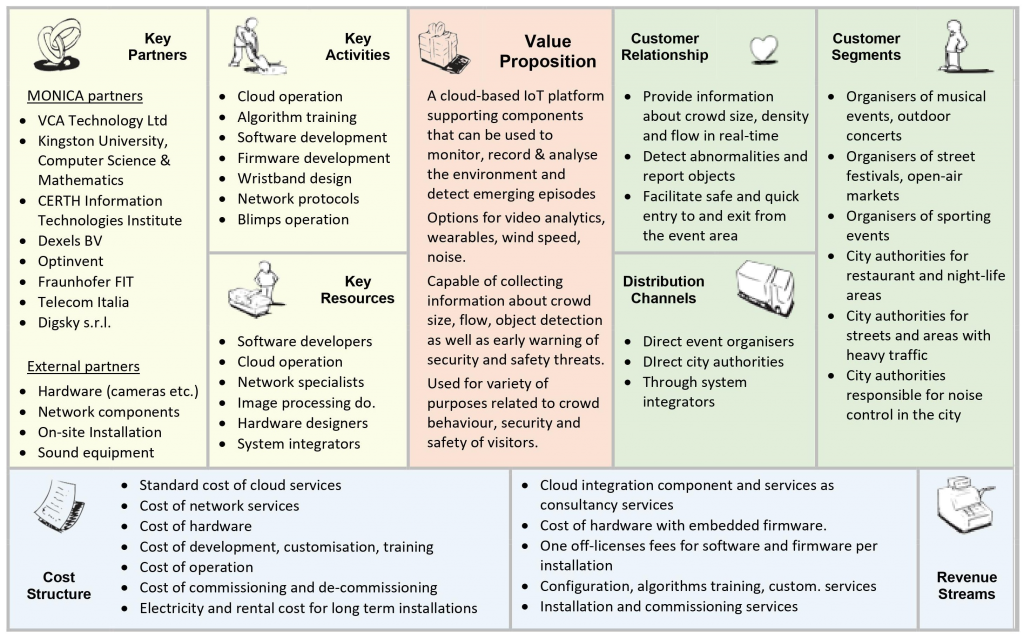
Business Model Canvas for the MONICA Crowd and Capacity Monitoring solution © In-JeT ApS
Revenue models
The choice of business model and pricing schemes is entirely up to the partner that have commercialised the solutions. Hence, the following information is solely provided as a guide to the expected business conditions that the solutions might be provided at. Please contact the responsible partner for further, up-to-date details.
| Components | Type | Anticipated revenue model |
|---|---|---|
| Camera platform VCAcore | Hardware, Firmware | VCA framework with 3rd party plugin wrapper is available as commercial hardware with embedded firmware. Optional planning services are available at a cost. |
| Security Fusion Node | Firmware | The Security Fusion node is available as a tailored solution including hardware and firmware at a one-off cost. If required, installation, integration, update and consultation are subject to further fees. |
| MONICA Platform Core Enabler | Cloud service | The cloud services is available as a Platform as a Service (PaaS) service. The Platform Core Enabler is available as a Platform as a Service (PaaS) solution, extended by integration services of the appropriated auxiliary enabler(s). Planning service is always required as an additional one-off charge. |
| MONICA cloud integration enablers | Firmware | The cloud integration component consists of the MONICA Platform Core Enabler combined with the MONICA Crowd Loop Enablers are provided as one-off license fees per camera. |
| Crowd density, optical flow and object detection algorithms | Algorithm | Firmware one-off license per camera for all algorithms1. If required, installation, integration, update and consultation are subject to further fees. Optical flow algorithm is licensed under Apache License, version 2.0, crowd density and object detection algorithms under MIT license. |
| Human and object detection | Algorithm | Firmware one-off license per camera for human and object detection algorithms. |
| Crowd density estimation | Algorithm | Firmware one-off license per camera for crowd density estimation algorithms. |
| People gate counting algorithms | Algorithm | Firmware one-off license for per camera people counting algorithms |
| Fight detection | Algorithm | Firmware one-off license per camera for fight detection algorithms. |
| Staff wristband | Hardware, Network,Infrastructure | The wristbands are available as commercial hardware with embedded firmware. MONICA firmware is available as one-off license per solution. Planning service is always required as a one-off charge. |
| Crowd wristbands | Hardware, Network,Infrastructure | The crowd wristband solution is available as a complete event solution including hardware, network, operation and data analysis. |
| Smart glasses | Hardware, Firmware | The Smart Glasses are available as commercial hardware with embedded firmware. Monicora firmware is available as a one-off license per solution. |
| Live Positioning Information System (LiPS) | Hardware, Firmware | The Live Positioning Information System (LiPS) solution is available as a complete event solution including hardware, network, operation and data analysis. |
| OneM2M compliant gateway | PaaS | The external M2M gateway is offered as a Platform-as-a-Service solution. |
Reference deployments in MONICA
During the project period 2017 – 2020, the MONICA Crowd and Capacity Monitoring solutions in various forms were deployed and tested in real-life situations during planned pilot events. Validated results from these reference implementations can be found in D9.2 Final Assessment and Validation Report of the MONICA IoT Platform. Follow the links below to read articles about the demonstrations.
| MONICA demonstration events | |
|---|---|
Ville de Lyon
|
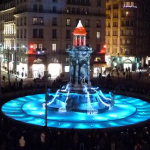 Fête des Lumières 2018 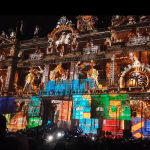 Fête des Lumières 2019 |
Città di Torino
|
 San Salvario  Kappa FuturFestival 18  Kappa FuturFestival 19 |
Stadt Bonn
|
 Pützschens Markt 18  Puetzchens Markt 19  Rhein-in-Flammen 19 |
Tivoli, Copenhagen
|
 Tivoli Fredagsrock |
Stadt Hamburg
|
 SpringDOM 2019 |
Leeds Cricket & Rugby
|
 Headingly Stadium 18 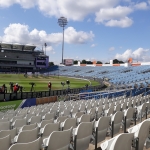 Leeds Cricket 18 |
For more information, please see the contact list below
Replicators
Due to the large amount of planned demonstrations of the MONICA Crowd and Capacity Monitoring solutions, no replication demonstrations were undertaken. However, some of the sensors components were replicated in the UE2-Visitor Experience.
The following partners are responsible for various components of the MONICA IoT SLM solution:
| Solution | Responsible | Acronym | Details |
|---|---|---|---|
| Camera platform VCAcore | VCA Technology Ltd | VCA | VCA can provide CCTV cameras with build-in VCAcore framework |
| Security Fusion Node | Kingston University, Computer Science & Mathematics | KU | KU can provide the Security Fusion Node |
| MONICA Platform Core Enabler | Atos IT Solutions and Services | ATOS | ATOS can provide the MONICA Platform Core Enabler as a Platform as a Service (PaaS) and the system integration of the MONICA components (when using the cloud) |
| MONICA cloud integration enablers | VCA Technology Ltd | VCA | VCA can provide CCTV cloud communication firmware for the VCAcore framework cloud communication |
| Crowd density, optical flow and object detection algorithms | Kingston University, Computer Science & Mathematics | KU | KU can provide algorithms for the analysis of crowd density and objects. Types of events may be customised. |
| People gate counting algorithms | VCA Technology Ltd | VCA | VCA can provide algorithms for the analysis of crowd estimation, gate counting, etc. |
| Human and object detection algorithms | CERTH Information Technologies Institute | CERTH | CERTH can provide algorithms for image analysis and feature detection, e.g. humans and objects. |
| Fight detection algorithms | CERTH Information Technologies Institute | CERTH | CERTH can provide algorithms for fight detection. |
| Staff Wristband | Dexels BV | DEXELS | Dexels can provide the staff wristbands |
| Crowd Wristbands | Dexels BV | DEXELS | Dexels can provide the crowd wristbands |
| Smart Glasses | Optinvent | OPTIN | Optinvent can provide ides the Smart Glasses |
| Live Positioning Information System (LiPS) | Fraunhofer FIT | FIT | Fraunhofer FIT can provide the LiPS tracker and LoRa communication platform |
| OneM2M compliant gateway for External Platform Services | Telecom Italia | TIM | TIM can provide the M2M Network Service Capabilities Layer (NSCL) as a PaaS |
| BLIMP | Digsky s.r.l. | DIGISKY | Digisky can provide Blimp carriers for air-borne camera solutions. |
| IoT Enabled Sound Level Meters | Brüel & Kjær | B&K | Brüel & Kjær may offer accredited IoT Enabled Sound Level Meters |


























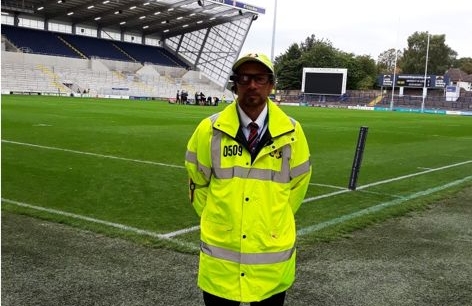




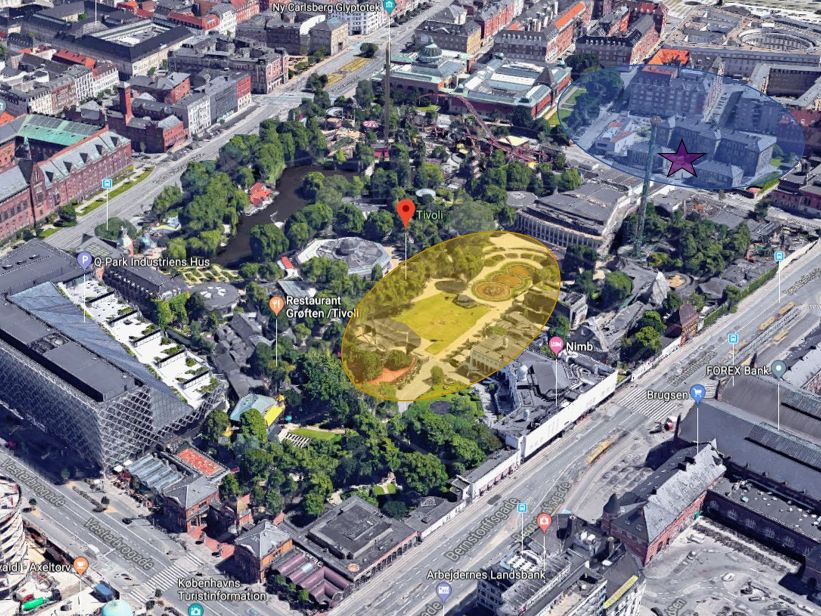






 ORA-2 Smart Glasses allows a Full See-through feature (Transparent display) for a mobile wearable device using Optinvent’s proprietary & patented display technology. The smart glasses have the following specification:
ORA-2 Smart Glasses allows a Full See-through feature (Transparent display) for a mobile wearable device using Optinvent’s proprietary & patented display technology. The smart glasses have the following specification: